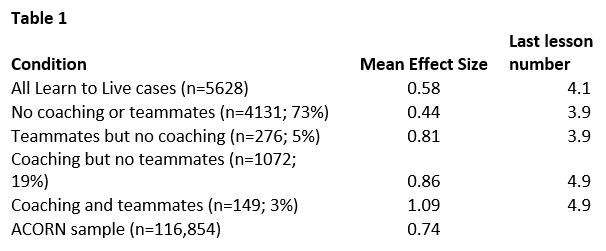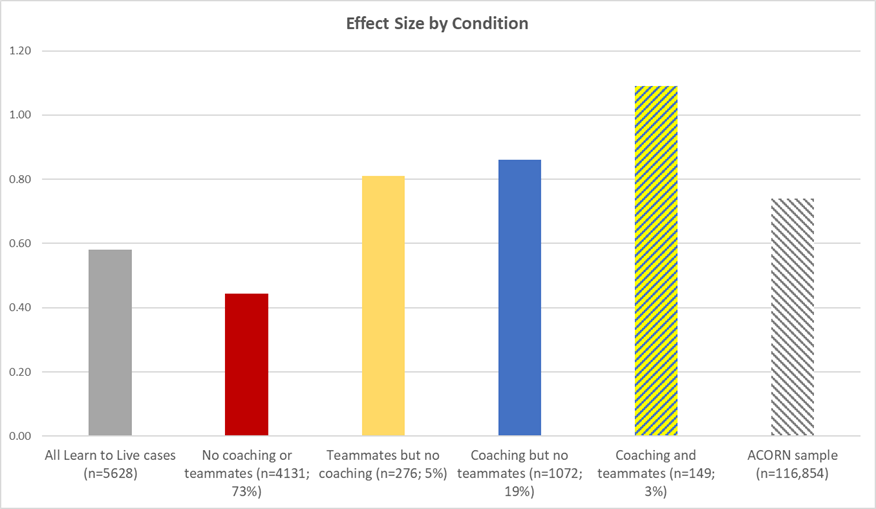Jeb S. Brown, Center for Clinical Informatics
Edward R. Jones, PhD, Learn to Live, Inc.
Published by the Society for the Advancement of Psychotherapy
Purpose
Research has shown that digital therapeutics (DTx) platforms using tools derived from therapies like CBT promote clinical change (Brown et al., 2020). It remains an open question what types of additional social support can improve those results. One such digital product, Learn to Live, has demonstrated improvement with personal coaching (Brown & Jones, 2021) and with automated text message support (Brown & Jones, 2022). The current study examines potential benefits from another type of support, that from friends and family who are notified by the digital user of their platform use.
Learn to Live offers this option to people at the time of enrollment to engage support from family and friends as “Teammates.” New users are offered the option of providing up to two email addresses for individuals who will be on their “team.” Learn to Live has no mechanism for knowing how much support any teammate provides a user of the platform. Teammates are contacted after the user enrollment process to notify them that their friend or family member will begin using one of the therapeutic modules. They are also contacted when lessons within the module are completed.
Method
The Learn to Live database has an indicator of whether or not the user included the teammate option. This permits evaluation of the outcomes for those choosing this option, and it allows investigation of the degree to which this option is associated with a larger effect size for those users who also engage other support options. For example, the coaching option was previously shown to be associated with larger effect sizes (Brown & Jones, 2022). Any additive effect would be a unique pathway to increase effectiveness.
As in our previous articles, the magnitude of improvement is reported using the effect size statistic. This statistic is routinely reported in studies of outcome and meta-analytic studies of outcome. Brown & Jones (2022) provides a detailed description of the methodology used to compute this statistic for Learn to Live questionnaires as well as data on outpatient psychotherapy from the ACORN Collaboration.
The SAS implementation of analysis of variance (ANOVA) is used to determine how much of the variance in outcome is explained by each of the four conditions studied. The conditions identified for analysis are: 1) use of the program without any additional support; 2) use of the program with coaching support; 3)use of the program with automated texting support (“mindfulness moments”), and 4) use of the program with teammate support. ANOVA permits evaluation of the relative contribution of each condition independently and additively.
The sample employed (n=5628) includes users of the platform in calendar years 2019 through 2021 who had at least two self-report measures in the system permitting an analysis of change.
Results
ANOVA found that two of the support conditions, coaching and teammates, had outcomes significantly greater than use of the platform without support (p<001). Mindfulness text message support did not differ significantly from the no support condition (>.10).
Table 1 presents the results for each of the conditions and for the ACORN psychotherapy sample which has been used in the previous Learn to Live studies as a reference point.
Graph 1 displays the effect sizes graphically. It appears that the effect for teammates support is independent of and additive to the effect for coaching, and this is confirmed by the ANOVA. The effect size for combined coaching and teammates was significantly larger than for either the coaching or teammates condition alone.
The mediating effect of lesson utilization was analyzed. Interestingly, coaching was associated with completing more lessons, while teammates appeared to add to the effect size without increasing the number of lessons.
Discussion
The results are intriguing but should be interpreted with some caution. First, it must be stressed that correlation is not causation. One plausible explanation for the results is that users choosing support are more motivated and/or ready to accept help than others. User factors (much like patient factors) are likely to be contributing to the results, if not explaining them in totality. Something is likely to be different about these users selecting support.
These results are generally consistent with research on psychotherapy highlighting the importance of the therapeutic relationship in driving clinical change (Wampold??). The emerging modality of DTx is generally limited to providing therapeutic techniques without an element of personal support. People who select some type of personal contact or support have been found in three studies (Brown & Jones, 2021, 2022, and the present study) to have superior outcomes over those who only utilize the therapeutic tools.
In all, 26% of users opted for coaching and/or teammates support. From a quality improvement perspective, the next step would be to find ways to increase participation in both program options. However, the coaching support requires hiring staff to meet increased demand, while the teammates option has minimal additional expense. This is an important business consideration, and so the current results merit further study of larger samples before business decisions are based on them.
References
Brown, J. S., Jones, E., & Cazauvieilh, C. (2020, May). Effectiveness for online cognitive behavioral therapy versus outpatient treatment: A session by session analysis. [Web article]. Retrieved from http://www.societyforpsychotherapy.org/effectiveness-for-online-cognitive-behavioral-therapy-versus-outpatient-treatment
Brown, J., & Jones, E. (2022, May). Improving results for digital therapeutics. [Web article]. Retrieved from http://www.societyforpsychotherapy.org/improving-results-for-digital-therapeutics

